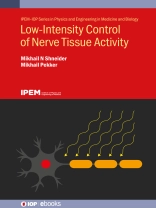Our book is written primarily for biologists and physicians but also for physicists, engineers, and students who want to understand the mechanisms of stimulation and signal propagation in nervous tissue. It describes in detail the mechanism of ephaptic coupling, which involves the transmission of excitation from an active neuron to a nearby inactive neuron through a conducting intercellular medium. This connection plays an important role in the functioning of the nervous system.
The book explains how the interaction of the axon membrane with the electric field of low-intensity microwave radiation leads to a redistribution of transmembrane ion channels in the region of the initial segment of the axon, resulting in an increase or decrease in the threshold for action potential excitation, depending on the radiation intensity.
Key Features:
-
Incorporates understanding biophysical processes which open up the possibility of developing new material devices that can be used in medical practice, particularly in terms of pain management.
-
The authors believe that the book stimulates new experimental and theoretical research in the influence of weak microwave fields on the activity of the nervous tissue and physiological processes. Actual experimental techniques are incorporated where appropriate.
-
The materials presented in this book will be useful for engineers, scientists, and physicians in terms of the development of significant new advances in pain management.
-
It can be used for additional sections in undergraduate and graduate courses for students studying medical physics, biophysics and neuroscience.
Innehållsförteckning
Preface
Acknowledgements
Author biographies
Nomenclature
1 Historical review
2 Ephaptic coupling and related phenomena
3 On the criteria of nonthermal interaction of cell membranes exposed to microwave radiation
4 Nonthermal weak microwave field impact on nerver fiber activity
5 Interaction between electrolyte ions and the surface of a cell lipid membrane
6 Bypassing damaged areas in neural tissues
7 Theoretical model of external spinal cord stimulation
8 Anesthesia stimulated by a train of electrical pulses
9 Effects of osmotic pressure variations on cell membranes
Om författaren
Dr. Mikhail Shneider has a Ph D in Plasma Physics and Chemistry from the All-Union Electrotechnical Institute in Moscow, and he also has a Doctor of Sciences degree in Plasma Physics and Chemistry from the Institute for High Temperatures, Russian Academy of Sciences, Moscow. Since 1998 up until the present time, Dr. Shneider has been working as a Senior Research Scientist within the Department of Mechanical and Aerospace Engineering, Princeton University. His research interests are in the theoretical study of discharge physics, gas and hydrodynamics, non-linear optics, and biophysics. He has published about 250 papers and 2 books. He is the recipient of the 2020 AIAA Plasma Dynamics and Lasers Award and Medal.
Dr. Mikhail Pekker has a Ph D in physics and mathematics from the Institute of Theoretical and Applied Mechanics in Russia. From 1993-2007, he worked in the Institute of Fusion Studies at the University of Texas, Austin, from 2010 – 2014 at Drexel University and 2015 – 2017 in the Department of Mechanical and Aerospace Engineering at George Washington University. At present he is retired, but still conducts research in gas discharge physics, cavitation, cosmology, and biophysics. Dr. Pekker has more than 100 publications and 1 book.












